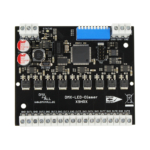NanoSD Player
Art. Nr.: 99-4601
Eigenschaften
- Umschaltbarer Ausgang
- DMX oder LED Pixel Output
- Kompatibel mit vielen Digitalen LED Typen
- Einstellbare Pixelgruppe
- Einstellbare Farbwiedergabe
- Hochwertige und kompakte Ausführung
- Einfache Konfiguration
- Firmware-Update-Funktion
Unterstützte LED Typen
| Pixelgruppe 1 | Pixelgruppe 2-99 | |
| APA-101 | max. 680 Pixel* | max. 4097 Pixel* |
| APA-102 | max. 680 Pixel* | max. 2039 Pixel* |
| APA-104 | max. 680 Pixel* | max. 680 Pixel* |
| DycoLED PB3 | max. 680 Pixel* | max. 4097 Pixel* |
| DycoLED PC5 | max. 326 Pixel* | max. 326 Pixel* |
| GS8208 | max. 680 Pixel* | max. 680 Pixel* |
| INK1002 | max. 680 Pixel* | max. 680 Pixel* |
| INK1003 | max. 680 Pixel* | max. 680 Pixel* |
| LPD1101 | max. 680 Pixel* | max. 4097 Pixel* |
| LPD6803 | max. 680 Pixel* | max. 4097 Pixel* |
| LPD1886 8Bit | max. 680 Pixel* | max. 907 Pixel* |
| LPD1886 12Bit (8bit controlled) |
max. 680 Pixel* | max. 680 Pixel* |
| LPD8803 | max. 680 Pixel* | max. 2720 Pixel* |
| LPD8806 | max. 680 Pixel* | max. 2720 Pixel* |
| MagiarLED III flex | max. 680 Pixel* | max. 2039 Pixel* |
| SK6812 | max. 680 Pixel* | max. 680 Pixel* |
| SK6822 | max. 680 Pixel* | max. 680 Pixel* |
| SK9822 | max. 680 Pixel* | max. 2039 Pixel* |
| TM1804 | max. 680 Pixel* | max. 680 Pixel* |
| TM1812 | max. 680 Pixel* | max. 680 Pixel* |
| TM1814 | max. 508 Pixel* | max. 508 Pixel* |
| TM1829 (Low Speed) | max. 680 Pixel* | max. 680 Pixel* |
| TM1829 (High Speed) | max. 680 Pixel* | max. 680 Pixel* |
| UCS1903 | max. 680 Pixel* | max. 680 Pixel* |
| UCS1912 | max. 680 Pixel* | max. 680 Pixel* |
| UCS2903 | max. 680 Pixel* | max. 680 Pixel* |
| UCS2912 | max. 680 Pixel* | max. 680 Pixel* |
| UCS9812 (8bit controlled) |
max. 389 Pixel* | max. 389 Pixel* |
| UCS9812 (16bit controlled) |
max. 389 Pixel* | max. 389 Pixel* |
| WS2801 | max. 680 Pixel* | max. 2720 Pixel* |
| WS2811 | max. 680 Pixel* | max. 680 Pixel* |
| WS2812 | max. 680 Pixel* | max. 680 Pixel* |
| WS2812B | max. 680 Pixel* | max. 680 Pixel* |
| WS2813 | max. 680 Pixel* | max. 680 Pixel* |
| WS2815 | max. 680 Pixel* | max. 680 Pixel* |
| WS2818 | max. 680 Pixel* | max. 680 Pixel* |
| WS2821 (DMX) | max. 170 Pixel* | max. 170 Pixel* |
| * Bezieht sich immer auf RGB Pixel | ||
Technische Daten
| Spannungsversorgung: | 5-12V DC (~ 300mA @ 5V / ~ 120mA @ 12V) |
| Anschluss: | Schraubklemmen |
| Eingänge: | IR-Sensor und Digitaler LongDistance Eingang zur Programmfortschaltung |
| Ausgangsprotokolle: | * siehe unterstützte LED Typen |
| Output Port 1: | max. Pixel (bei RGB) * siehe unterstützte LED Typen oder max. 512 DMX Kanäle |
| Programmspeicher: | MicroSD-Karte (4GB enthalten) |
| Farbreihenfolge: | RGB / RGBW einstellbar SingleColor weiß, rot, grün, blau |
| Pixelgruppen: | Einstellbar, 1-99 Pixel |
| Weitere Funktionen: | Cue-List RGB-Filter Firmware-Update-Funktion |
| Abmessung: | 70 x 42 x 23 mm |
Bedienungsanleitung
Firmware
NanoSD Player
Der NanoSD Player ist ein Stand-Alone DMX- oder LED-Pixel-Player.
Am Ausgang kann direkt ein digitaler LED-Stripe angeschlossen werden.
Umschaltbarer Ausgang
Der Ausgang des NanoSD Player ist zwischen DMX und verschiedenen LED Steuersignalen umschaltbar.
Somit lassen sich DMX-Geräte oder digitale LED-Stripes, bei denen die einzelnen LEDs einzeln
angesteuert werden können, direkt vom NanoSD Player aus ansteuern.
Verschiedene LED-Chips
Der NanoSD Player unterstützt viele verschiedene LED-Chips.
Eine Auflistung der möglichen LED-Chips ist in den Technischen Daten zu finden.
Blaue LED-Anzeige
Die LED-Betriebsanzeige am NanoSD Player ist mit einer blauen LED ausgeführt.
IR-Sensor
Über den eingebauten IR-Sensor ist die Bedienung des NanoSD Player mittels einer optionalen IR-Fernsteuerung möglich.
Einfache Konfiguration
Eine benutzerfreundliche Konfiguration über den DMX-Configurator ermöglicht eine schnelle und
unkomplizierte Einstellung aller Parameter und das Erzeugen der wiederzugebenen Programme.
Programmierung durch SD-Karte
Die Programmierung erfolgt ausschließlich über eine SD-Karte.
Somit sind alle Einstellungen projektabhängig verfügbar.
Hochwertige und kompakte Ausführung
Der NanoSD Player ist mit zwei 3-poligen Schraubanschlüssen in einem kompakten Aluminium-Gehäuse ausgeführt.
Firmware-Update-Funktion
Um zukünftige Funktionen nutzen zu können bietet der NanoSD Player eine Firmware-Update-Funktion.
























